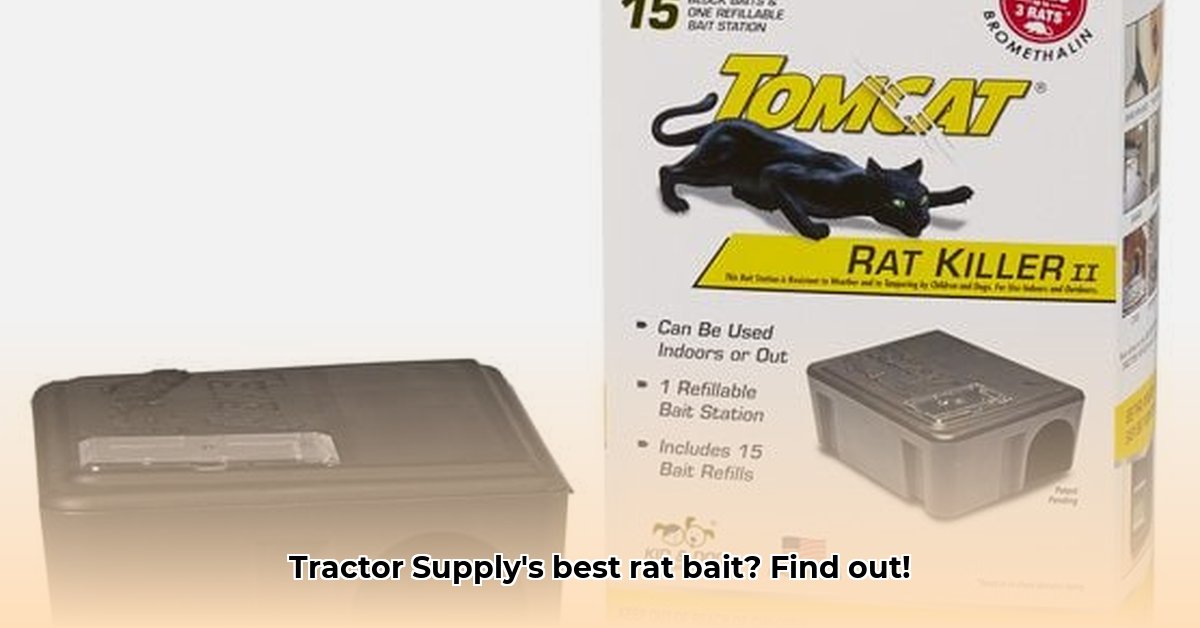
Understanding Your Rodent Situation: The First Step to Effective Control
Before purchasing rat bait, identifying the specific rodent infestation is paramount. Are you dealing with mice or rats? The size and behavior of the rodents will influence your bait choice and placement strategy. A quick assessment of the infestation's scale—a few droppings versus a significant infestation—will help determine the amount of bait needed. Photographing any signs of rodent activity (droppings, gnaw marks) can aid in seeking further advice from Tractor Supply staff.
Exploring Your Options at Tractor Supply: Types of Rodent Bait
Tractor Supply offers several rodent control products, each with unique characteristics:
Rodenticide Blocks: These durable, weather-resistant blocks are ideal for outdoor use, providing long-lasting protection, particularly during harsh weather conditions.
Rodenticide Pellets: Smaller and easier to conceal, pellets are versatile for both indoor and outdoor applications, especially in areas requiring discreet bait placement.
Bait Stations: Essential for safety, bait stations protect children and pets from accidental exposure to rodenticides. Tractor Supply offers various models, from basic plastic boxes to weather-resistant designs, ensuring protection in diverse environments.
Selecting the Right Bait: Key Considerations
Choosing the appropriate bait involves several crucial factors:
Active Ingredient: The active ingredient determines the bait's effectiveness. Bromadiolone and difenacoum are common examples; research these ingredients to understand their mechanisms of action and potential implications. Consult with local pest control experts for tailored advice.
Bait Type: The choice between blocks (durable for long-term use) and pellets (easily hidden for discreet placement) depends on the specific environment and rodent behavior.
Bait Placement: Strategic placement near rodent activity areas (wall crevices, entry points, etc.) is vital. Always adhere to the product label instructions.
Safety: Prioritize safety by using bait stations exclusively. Tractor Supply offers a wide selection to accommodate various needs and locations.
Setting Up Your Bait Stations: A Step-by-Step Guide
Identify Rodent Activity: Locate areas with visible signs of rodent activity (droppings, tracks, gnaw marks).
Strategic Bait Station Placement: Position bait stations along walls, near entry points, or in identified rodent activity zones. Multiple stations may be required for larger infestations.
Secure Bait Access: Ensure bait accessibility is limited to rodents only, following packaging instructions for proper station setup and closure.
Continuous Monitoring: Regularly monitor and replenish bait as needed to maintain effective rodent control.
Safety Precautions: Handling Rodenticide Safely
Rodent control involves potentially hazardous materials; therefore, safety precautions are non-negotiable:
Child and Pet Protection: Keep bait stations out of reach of children and pets at all times.
Protective Gear: Wear gloves when handling bait to avoid skin contact.
Label Compliance: Strictly adhere to the manufacturer's instructions on the product label regarding safe use, storage, and disposal.
Bait Comparison: A Quick Reference Guide
| Feature | Rodenticide Blocks | Rodenticide Pellets | Bait Stations |
|---|---|---|---|
| Durability | High | Moderate | High |
| Discreetness | Low | High | Moderate |
| Weather Resistance | Excellent | Fair | Excellent |
| Child/Pet Safety | Low (unless in station) | Low (unless in station) | Excellent |
| Cost | Varies | Varies | Varies |
Remember, effective rodent control is an ongoing process. Consult your local Tractor Supply experts for personalized recommendations and support. A well-planned approach, combined with consistent monitoring and safety precautions, will effectively manage rodent infestations and protect your property.